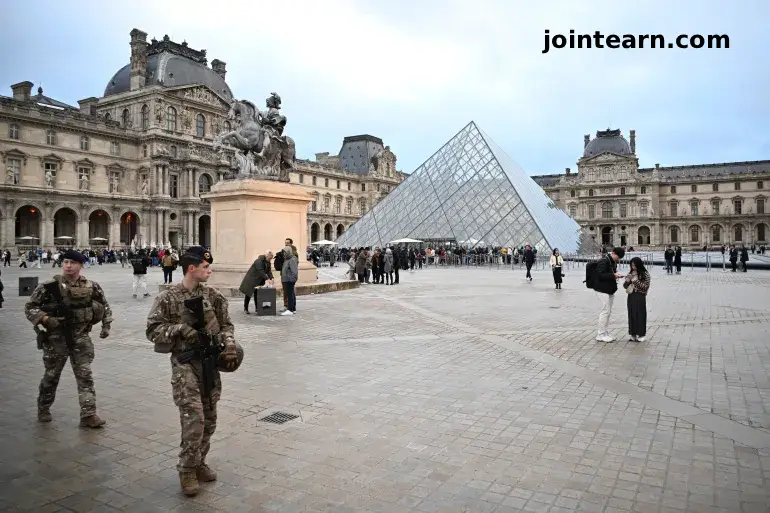
French police have arrested suspects connected to the spectacular jewellery heist at the Louvre Museum in Paris, one of the most daring thefts in modern French history. The Paris prosecutor’s office confirmed the arrests late Saturday, marking a breakthrough in the high-profile investigation that has gripped France and the global art world.
Key Arrests as Suspect Tried to Flee France
According to Paris Prosecutor Laure Beccuau, the arrests took place on Saturday evening. One suspect was detained at Paris-Charles de Gaulle Airport as he was about to board a flight abroad — reportedly bound for Algeria, according to Le Parisien. A second man was arrested shortly after in the Paris region.
Both men, said to be in their 30s and originally from Seine-Saint-Denis, are known to police for prior criminal activity. They are currently being held in custody on suspicion of organized theft and criminal conspiracy, French media reported.
The operation was carried out by France’s elite police antigang brigade (BRI), which has been leading the hunt for the suspects behind the audacious daylight robbery.
“The suspects’ arrests represent an important step forward,” Beccuau said in a statement. “But investigators are still working to recover the stolen jewels and identify all members of the network responsible.”
The prosecutor also condemned the unauthorized leaks to the media, warning that such disclosures could “hinder ongoing operations and the chances of recovering the priceless artefacts.”
A Four-Minute Daylight Robbery That Shocked the World
The heist occurred on October 19, 2025, when a group of intruders scaled the exterior walls of the Louvre Museum using the extendable ladder of a delivery truck. Exploiting what staff later described as a “blind spot” in the museum’s security system, the thieves entered a first-floor gallery and made off with eight historic pieces of royal jewellery.
Security footage revealed that the entire operation took just four minutes, making it one of the fastest and most brazen art-related crimes in recent decades.
As they fled, the thieves dropped a jeweled crown, but escaped with other items, including an emerald and diamond necklace gifted by Emperor Napoleon Bonaparte to Empress Marie Louise, his second wife.
Officials estimate the total value of the stolen pieces at $102 million, though experts emphasize their cultural and historical significance is incalculable.
CCTV, DNA, and Fingerprints: The Investigation Tightens
Since the heist, investigators have been meticulously reviewing public and private security footage across Paris. Prosecutor Beccuau said surveillance videos helped authorities trace the suspects’ movements within the city and surrounding suburbs.
Dozens of DNA samples and fingerprints were also collected from the scene, reportedly giving detectives a “strong forensic trail” to follow.
French law enforcement agencies have faced intense scrutiny over how such a theft occurred in the world’s most visited museum, which attracts more than 30,000 visitors a day. The Louvre’s director called the theft a “terrible failure” and promised a comprehensive overhaul of security systems.
A String of High-Profile Museum Robberies in France
The Louvre heist comes amid a troubling rise in museum thefts and cultural property crimes across France.
Just 24 hours after the Louvre robbery, a museum in eastern France reported the theft of a collection of gold and silver coins, discovered when staff found a shattered display case.
In September, thieves broke into the Paris Natural History Museum and stole gold nuggets valued at $1.5 million. A Chinese national was later arrested and charged in connection with that theft.
These incidents have prompted calls for a nationwide review of museum security standards, particularly in institutions housing valuable historical artefacts.
“This is not just about stolen jewellery,” said Jean-Claude Bérard, a Paris-based art security expert. “It’s about the vulnerability of France’s cultural heritage — a problem that requires urgent, coordinated reform.”
What’s Next: Global Hunt for Missing Jewels
The latest arrests have given investigators hope that at least some of the missing items can be recovered before they are sold or smuggled abroad. French police are reportedly working with Interpol and European partners to track possible movements of the jewels through criminal networks in North Africa and Eastern Europe.
Authorities believe the heist was highly coordinated, involving individuals with professional knowledge of security systems and museum layouts.
While two suspects are in custody, other members of the network remain at large, and police have not ruled out the involvement of international crime syndicates specializing in luxury theft.
Public Reaction and Security Overhaul
The Louvre reopened the day after the heist, though some galleries remained closed as investigators examined the crime scene. Visitors and art lovers have expressed a mixture of shock and outrage, with many calling for accountability from museum officials.
The incident has also reignited a public debate in France about the privatization of museum security and whether cost-cutting measures have compromised the protection of national treasures.
In response, France’s Ministry of Culture announced plans to conduct an independent security audit of all major museums, including the Louvre, the Musée d’Orsay, and the Château de Versailles.
A Heist for the History Books
The Louvre jewellery heist has already been compared to some of the most famous art thefts in history — from the 1911 theft of the Mona Lisa to the 1990 Isabella Stewart Gardner Museum robbery in Boston.
While police are optimistic about the latest arrests, experts warn that unless swift recovery efforts succeed, the stolen artefacts could disappear into the black market for decades.
“Time is of the essence,” said Bérard. “Once these items are broken up or sold, recovering them becomes almost impossible.”
For now, France — and the world — watches closely as investigators race to recover the treasures stolen from the heart of Paris’s most iconic museum.


Leave a Reply